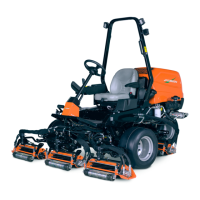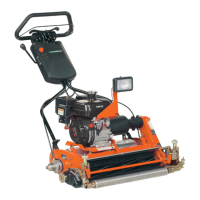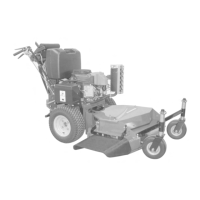HYDRAULICS
4181383 First Edition 6-31
6
IMPORTANT
M
Depending on the machine model number and
production date, the possibility exists that the hoses
connected to the center and rear sections of the gear
pump could be reversed. This design change does
not affect the operation of the mower, but will affect
the outcome of this test as outlined. Please confirm
that the hose connected to the center section of the
gear pump is connected to deck valve port “P2”.
Please see “Hydraulic Schematic” on page 6-6 for
additional information.
Figure 6-23
3. Disconnect hose (1) from fitting (2).
Figure 6-24
4. Install tee fitting (5) to fitting (2).
5. Connect test hose (6) of flow meter inlet and hose (1)
to tee fitting (5).
NOTE
Make sure hose end is under oil level in hydraulic tank to
prevent aeration of oil.
6. Connect flow meter outlet hose (3) to the hydraulic
tank.
!
WARNING
7. Install suitable blocking device or tool in left rear
cutting unit, preventing cutting unit from turning.
Open flow meter valve (4) completely.
8. Bypass seat switch.
NOTE
Verify engine rpm is within specification (2850 rpm ± 50)
to ensure accurate hydraulic test results.
9. Start engine and run at full throttle (2850 rpm ± 50).
10. Use the flow meter to warm the hydraulic oil. Turn the
flow meter valve (4) until a reading of 1300 psi (90
bar) or one half of the relief valve rating is reached.
Warm oil to 120—150°F (49—65°C); open valve fully
after operating temperature is reached.
11. Disconnect park brake switch.
12. Engage cutting unit switch.
13. Read and record the rear cutting units pump no load
flow.
14. Slowly close flow meter valve (4) until pressure
reaches 1950 psi (134 bar). Read and record the
rear cutting units pump loaded flow.
15. Open flow meter valve (4) and stop engine.
16. Calculate rear cutting units circuit leakage.
(Step 13 – Step 14 / Step 13 x 100 = Leak
Percentage)
Is rear cutting units circuit leakage 10% or less?
YES The rear cutting units circuit is good.
Proceed to “Rear Cutting Units Motors Test”
on page 6-34.
NO Proceed to next question.
Is rear cutting units circuit leakage 11% to 20%?
YES The rear cutting units circuit is marginal.
Additional testing is required.
NO Proceed to next question.
Is rear cutting units circuit leakage 21% or more?
YES Test individual components in rear cutting
units circuit for leakage.
17. Disconnect and remove test equipment. Remove
blocking device or tool from cutting unit. Install all
hoses and fittings as noted prior to removal.
TN1410
1
2
5
6
TN1363
4
3
Safely block cutting unit from rotating using a
suitable device or tool. Failure to follow
appropriate safety precaution may result in death
or serious injury.

